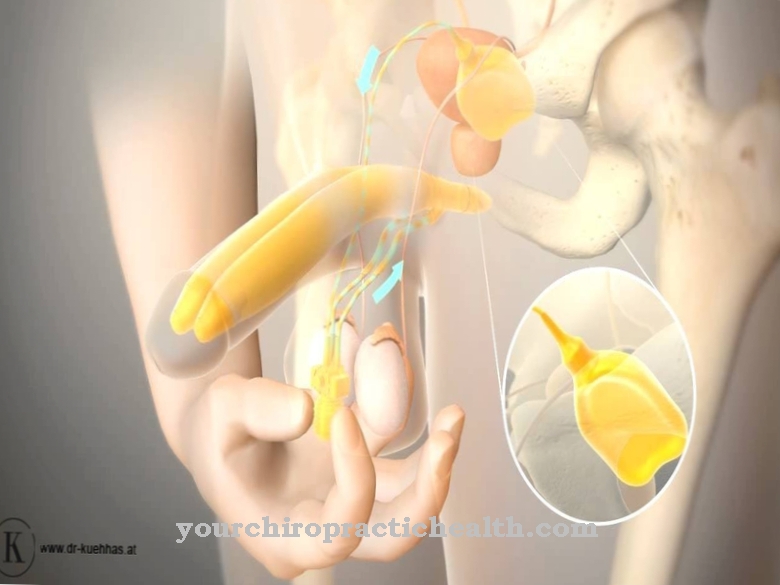The Digestive glands are important functional units of the digestive system that enable the breakdown of food components. Diseases of these organs often lead to serious digestive and metabolic disorders.
What is the digestive gland?
The digestive glands of the human digestive system include the salivary glands, the liver with the gallbladder, the glands of the gastric mucosa and the pancreas. Secretions, which are essential for digestion, are produced and secreted in the digestive glands. Without the secretions released by the digestive glands, the ingested food could not be broken down into its components. The secretions produced often contain enzymes that are used to digest carbohydrates, fat and protein.
In addition, there are digestive glands, which give off a slimy secretion to increase the lubricity of the food pulp. In addition, the secretions produced in the digestive glands can be used to adjust the pH of the chyme in order to optimize the breakdown of nutrients. Some enzymes only work under basic conditions, while other enzymes prefer an acidic or neutral environment. Without digestive glands, no digestion could take place.
Anatomy & structure
The first step in digestion takes place in the mouth through the saliva. Humans have a total of three large and many small salivary glands. The ear, mandibular and sublingual salivary glands are anatomically delimitable organs in the oral cavity. Many small saliva-producing glands are located directly in the lining of the mouth. The largest digestive gland in humans, the liver, is located in the right lower abdomen and can weigh up to 2kg. Overall, the liver consists of four lobes, which in turn are divided into eight functional segments. Histologically, the liver consists of so-called hepatocytes, which are responsible, among other things, for the production of bile.
The digestive glands of the stomach are part of the stomach lining. The cardiac glands are located at the entrance to the stomach. In the upper part of the stomach there are also the fundus glands, which form the gastric juice. The pyloric glands are located at the exit of the stomach. The pancreas is one of the most important digestive glands in humans. The organ in the upper abdomen rarely weighs more than 100g and is divided into three sections, the pancreatic head, the pancreatic body and the pancreatic tail.
Function & tasks
The salivary glands form the saliva that is released into the oral cavity. In an adult, significantly more than one liter of saliva can be secreted per day. Basically, this body fluid serves to make the ingested food slippery. Without saliva it would be almost impossible to swallow harder food components. The saliva also contains the enzyme amylase, which breaks down carbohydrates. In humans, carbohydrate digestion begins in the mouth.
In addition to the synthesis of proteins and fatty acids, the liver is primarily responsible for the production of bile acid. Bile acids are made by liver cells and released into the bile ducts, from where they flow into the gallbladder where they are stored. The bile contains lipases which enable fat to be digested. However, fat digestion does not begin in the small intestine. Fat molecules are already broken down enzymatically in the stomach. The lining of the stomach has three types of digestive glands. The cardiac glands secrete an alkaline mucus so that the pulp can be transported more easily.
In addition, the mucus serves to protect the organs of the digestive tract. The gastric juice is produced by the fundus glands. These glands also add pepsins to the food, which break down some of the proteins in the food. Just like the cardiac glands, the pyloric glands at the gastric outlet secrete basic mucus. The pancreas is located in close proximity to the stomach and liver. This digestive gland releases pancreatic juice into the duodenum. An adult's pancreas can produce up to two liters of secretion a day. The secreted secretion contains various enzymes for protein and carbohydrate digestion. It also contains lipases, which enable fat to be digested.
Diseases
The digestive glands of the body perform a multitude of important tasks for digestion and thus also for the body's energy balance. Therefore, diseases of these organs are often particularly serious. The salivary glands in the mouth can become inflamed and swollen; this is also known as sialadenitis. If the inflammation is not treated, it can lead to secondary diseases. More rarely, the cause of symptoms in the salivary glands is a tumor. Since the liver is a complex organ with a wide variety of functions, there are a number of diseases that can occur here.
A typical symptom of liver disease is jaundice. The mucous membranes and the skin turn yellow. Jaundice can be triggered by inflammation of the liver (hepatitis). In cirrhosis of the liver, hepatocytes die to a large extent, which massively disrupts the function of the liver. In addition to diseases of the liver tissue itself, the gall bladder can also cause symptoms. If the composition of the bile is not optimal, gallstones can form. Those affected then suffer from very painful colic.
In addition, inflammation can occur in the biliary duct. The stomach lining can also cause discomfort. Inflammation of the stomach lining (gastritis) is particularly widespread. If the pancreas becomes inflamed, pancreatitis is present, which is usually accompanied by severe pain. In the case of pancreatic insufficiency, part of the glandular tissue is destroyed, which is why a sufficient amount of pancreatic juice can no longer be released. Probably the best known disease associated with the pancreas is diabetes.
Typical & common diseases
- Sialadenitis
- Salivary stone
- Inflammation of the pancreas
- Inflammation of the stomach lining
- Diabetes mellitus
- Gallstones
- Biliary colic
- hepatitis



.jpg)






















